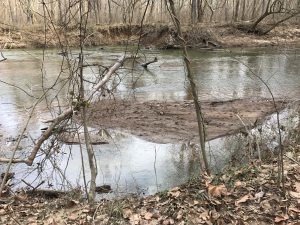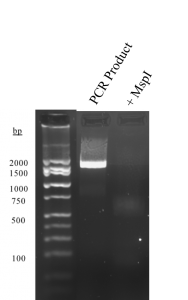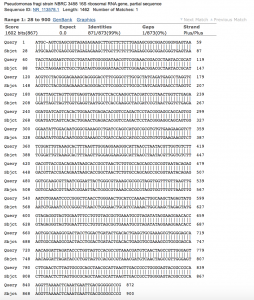Pseudomonas fragi is a white, circular colony that was found in the water of the Appomattox River. It has been previously found in China where it was used for treating urban sewage by detrification (Cristina Pellegrini, 2009).
References:
- Cristina Pellegrini, Paola Sandra Mercuri, Giuseppe Celenza, Moreno Galleni, Bernardetta Segatore, Elisa Sacchetti, Roberto Volpe, Gianfranco Amicosante, Mariagrazia Perilli; Identification of blaIMP-22 in Pseudomonas spp. in urban wastewater and nosocomial environments: biochemical characterization of a new IMP metallo-enzyme variant and its genetic location. J Antimicrob Chemother 2009; 63 (5): 901-908.
Date Collected: February 8, 2017
Methods for isolation and identification:
- A water sample was taken from on top the water of the Appomattox River (Figure 1). 100μl of the sample was placed on an agar plate and was incubated at 25 degrees Celsius for 48 hours. The plate was parafilmed and placed in the refrigerator for seven days.
- A dark orange, circular colony (Figure 2) was selected for 16S rRNA gene sequencing by PCR amplification.
- The PCR product was sent for DNA sequencing to identify the species of the bacteria.

Figure 1. Site of collection

Figure 2. Selected colony for identification
Results:
- MspI digestion (Figure 3): A bold band was produced at 2,000 bp by PCR.

Figure 3. Gel electrophoresis results of Appomattox River Water PCR product and + MSP1.
- DNA Sequence: The sequenced PCR product produced 873 quality base pairs that were used to identify the bacteria as Pseudomonas fragi. The chromatogram of the sequence is available as a pdf (HM04_PREMIX_JF7557_26). NCBI BLAST revealed 99% similarity with 1 gap out of 873 base pairs (Figure 4).

Figure 4. NCBI BLAST results of chosen colony.
Contributed by: Megan Bland and Hannah Hatke, BIOL 250 Spring 2017